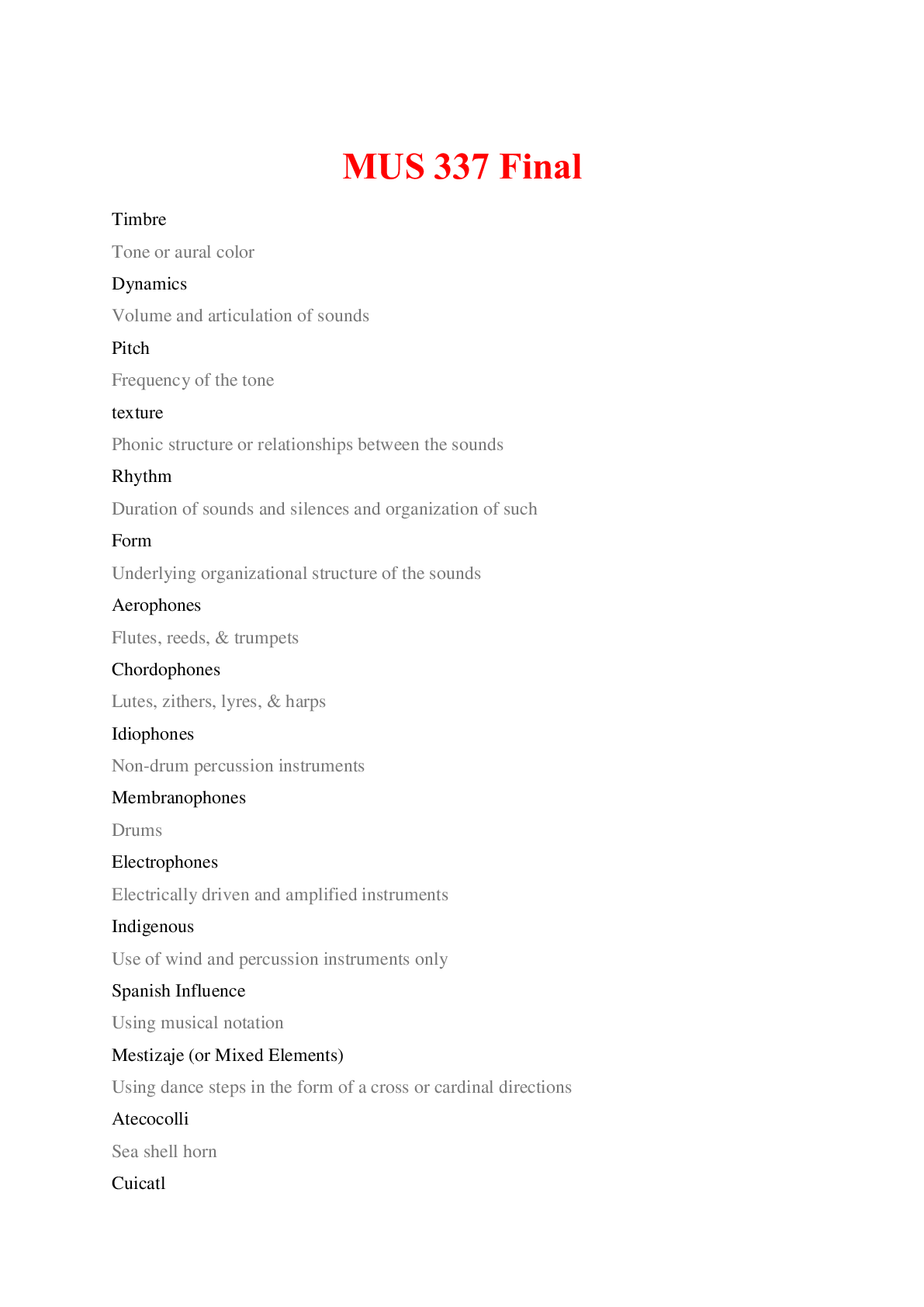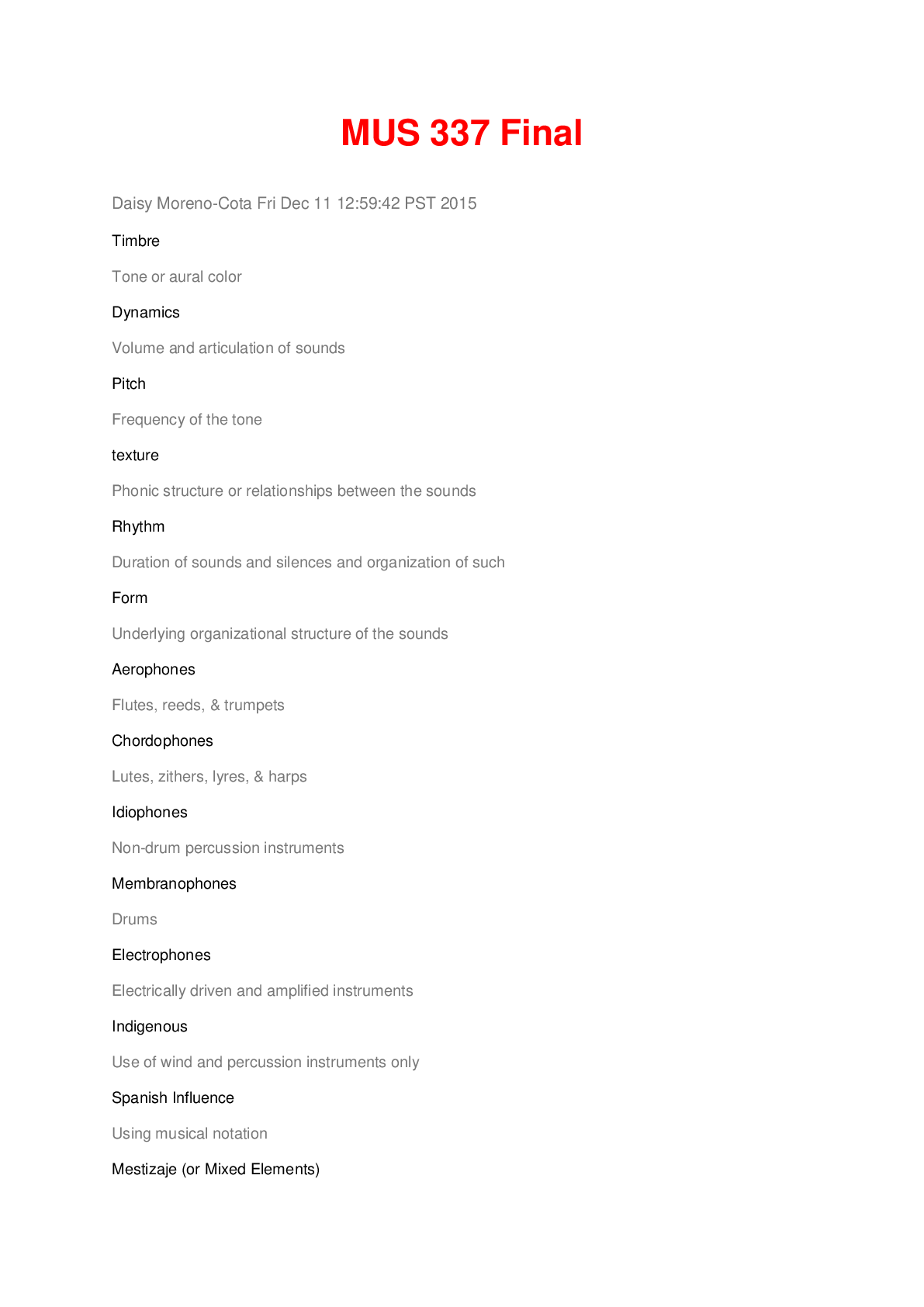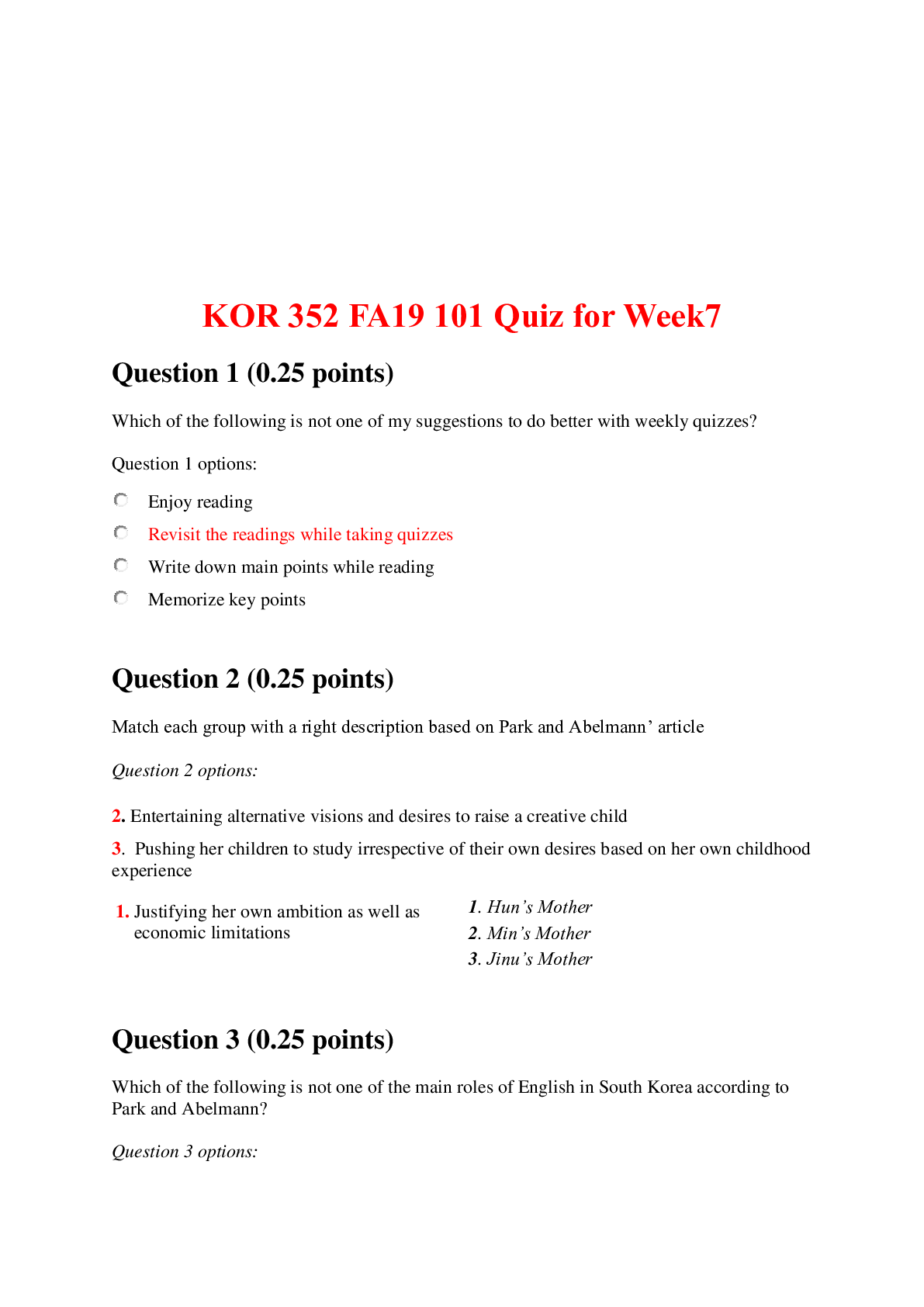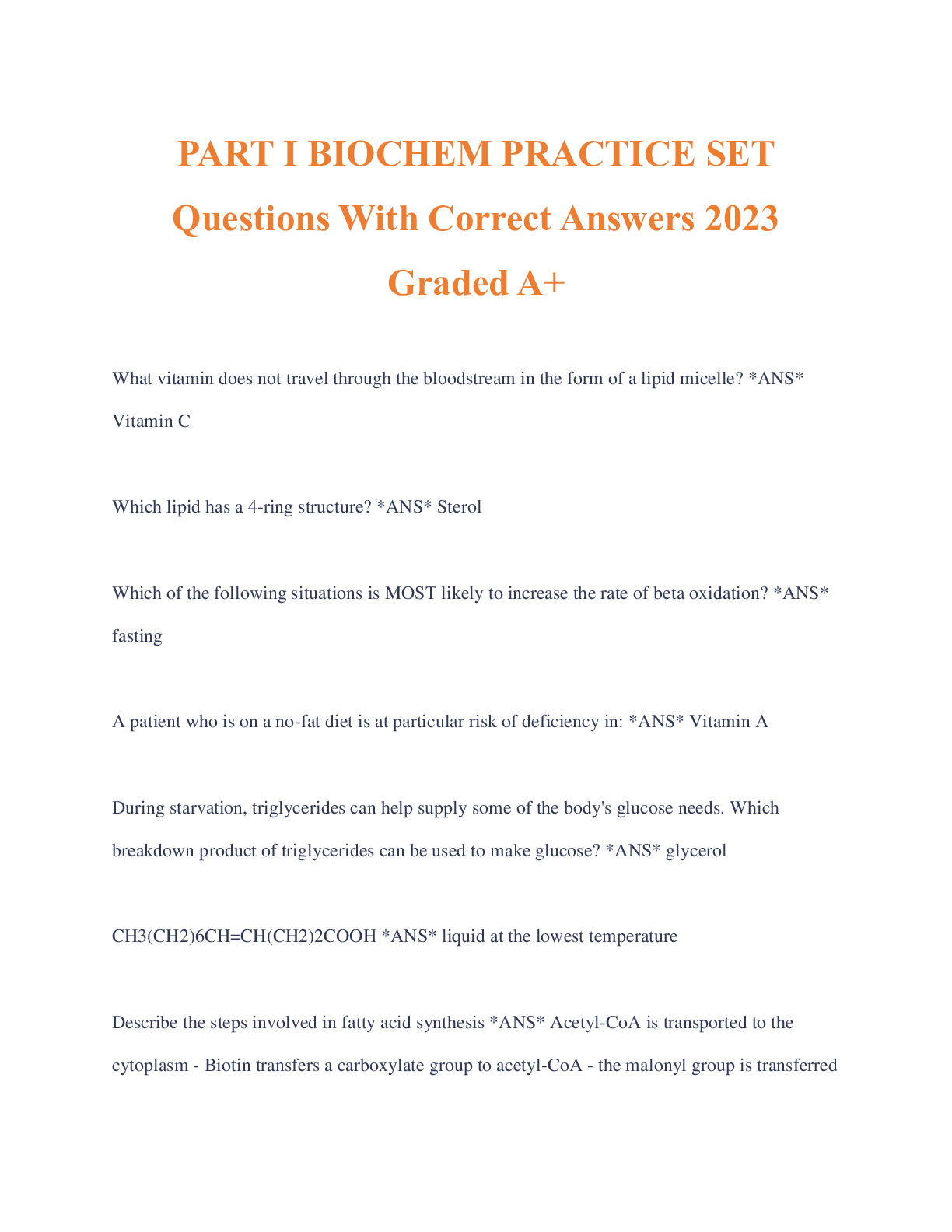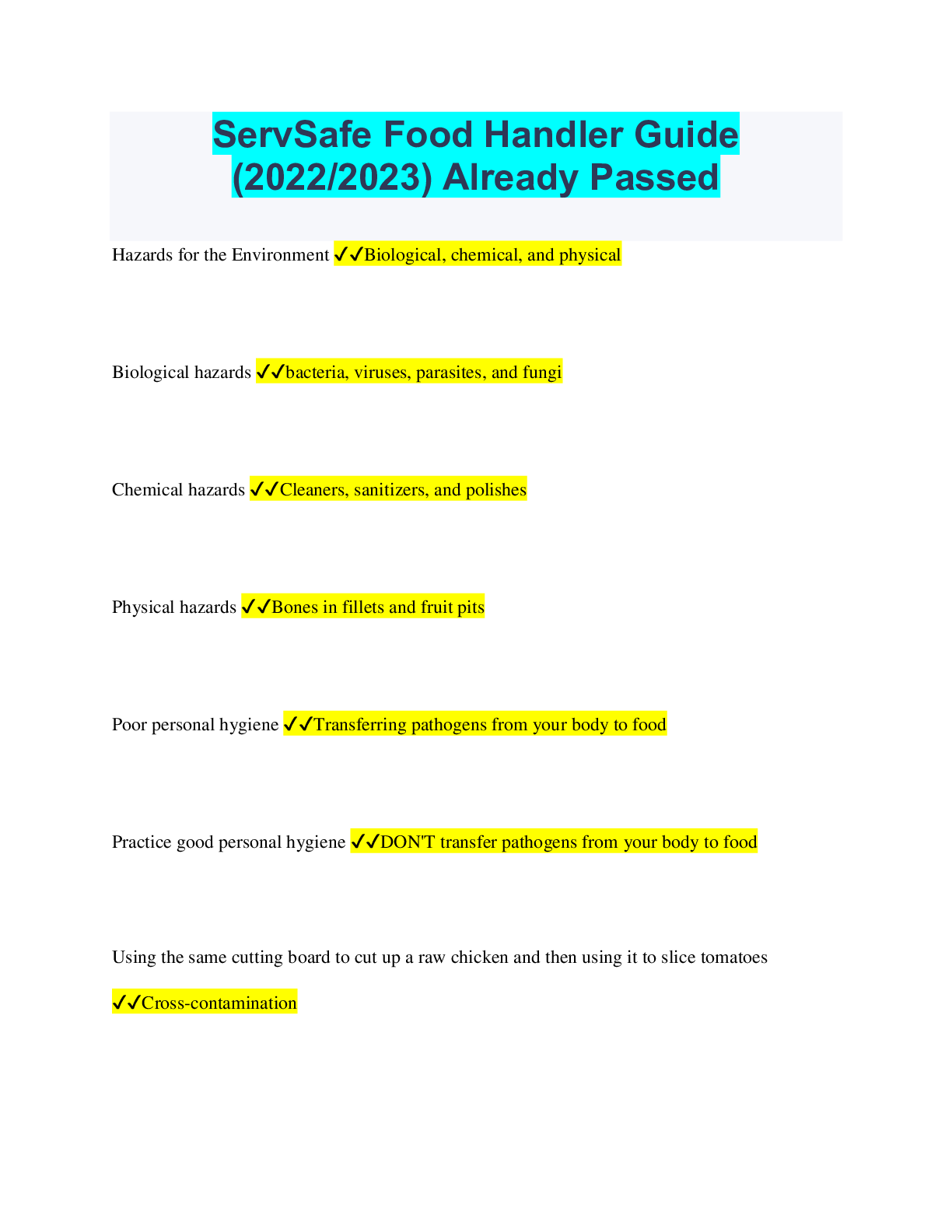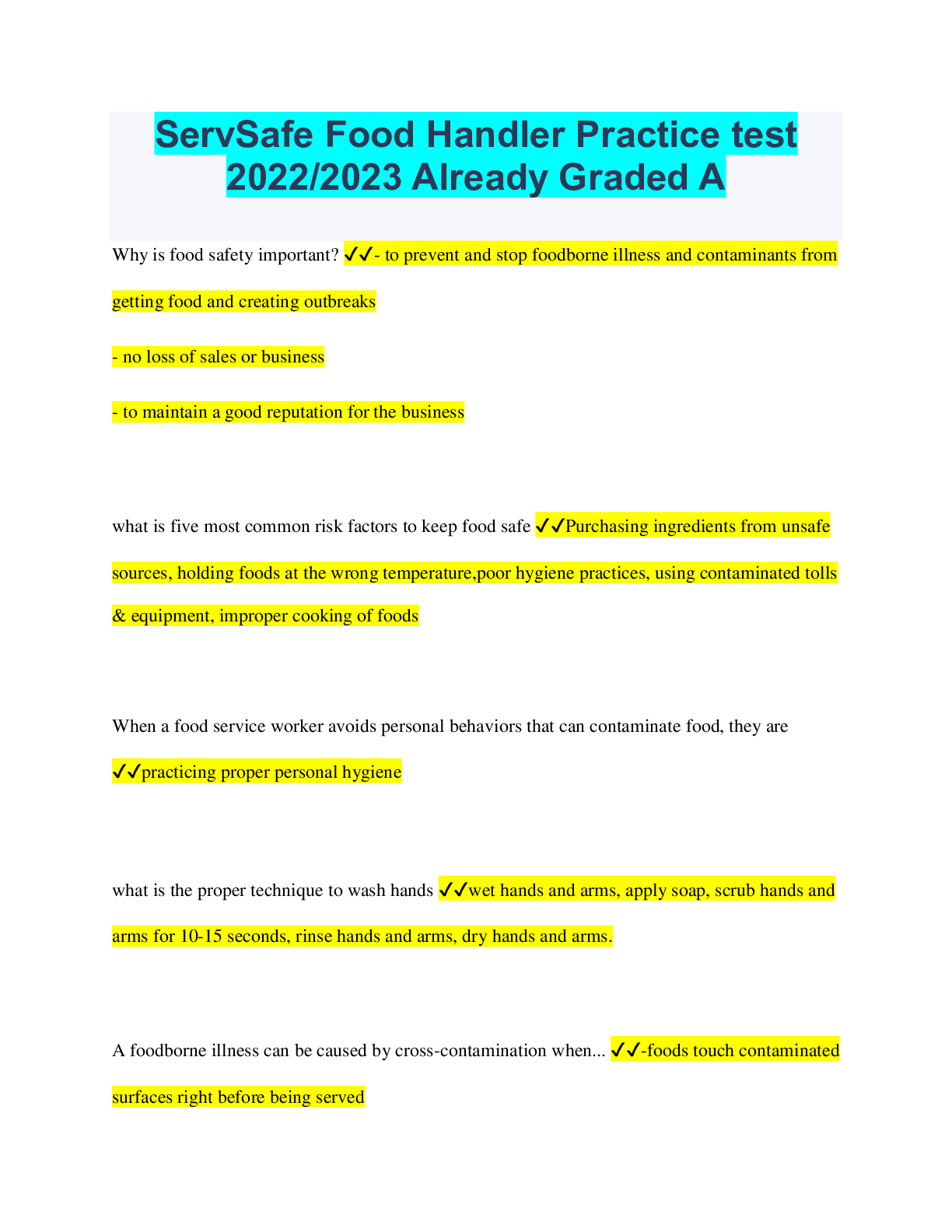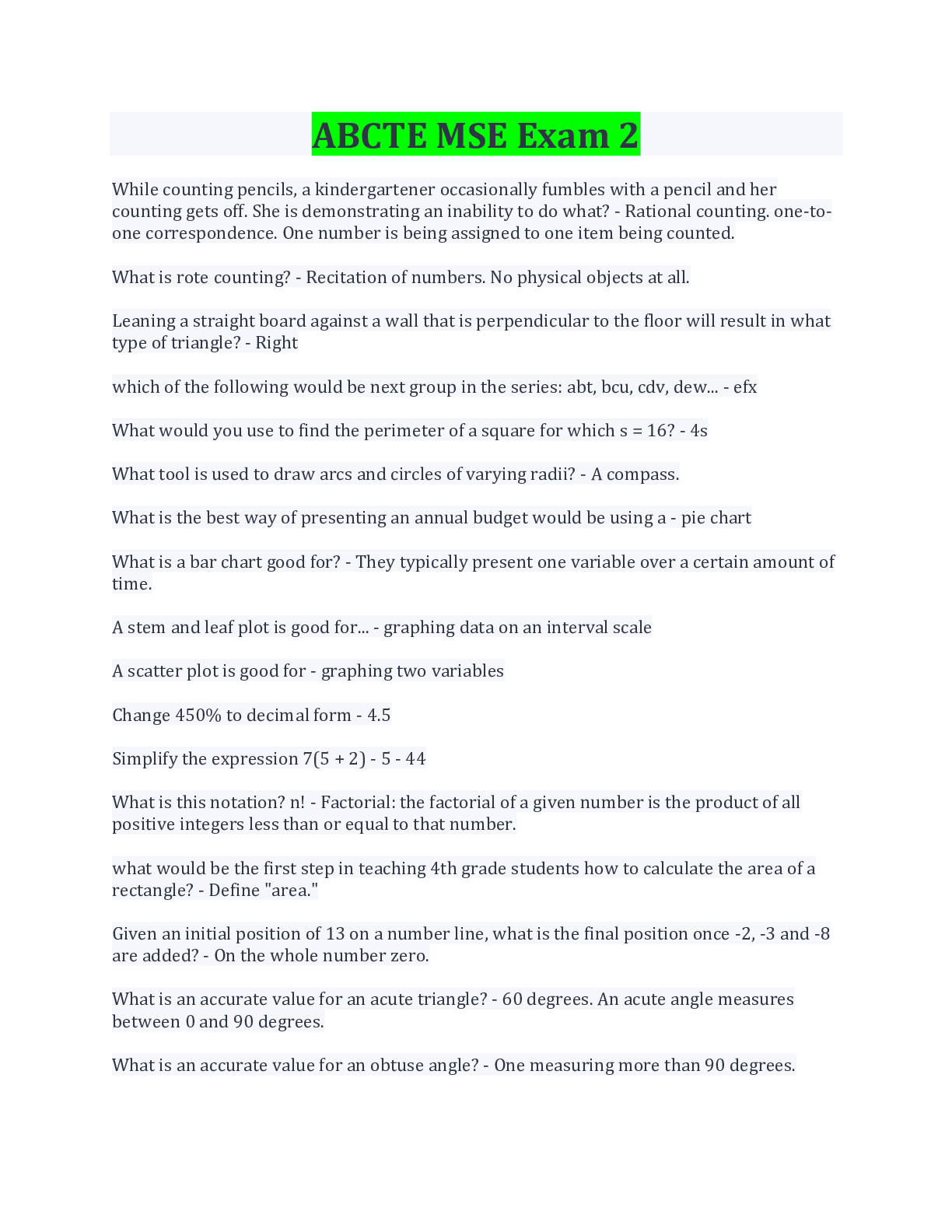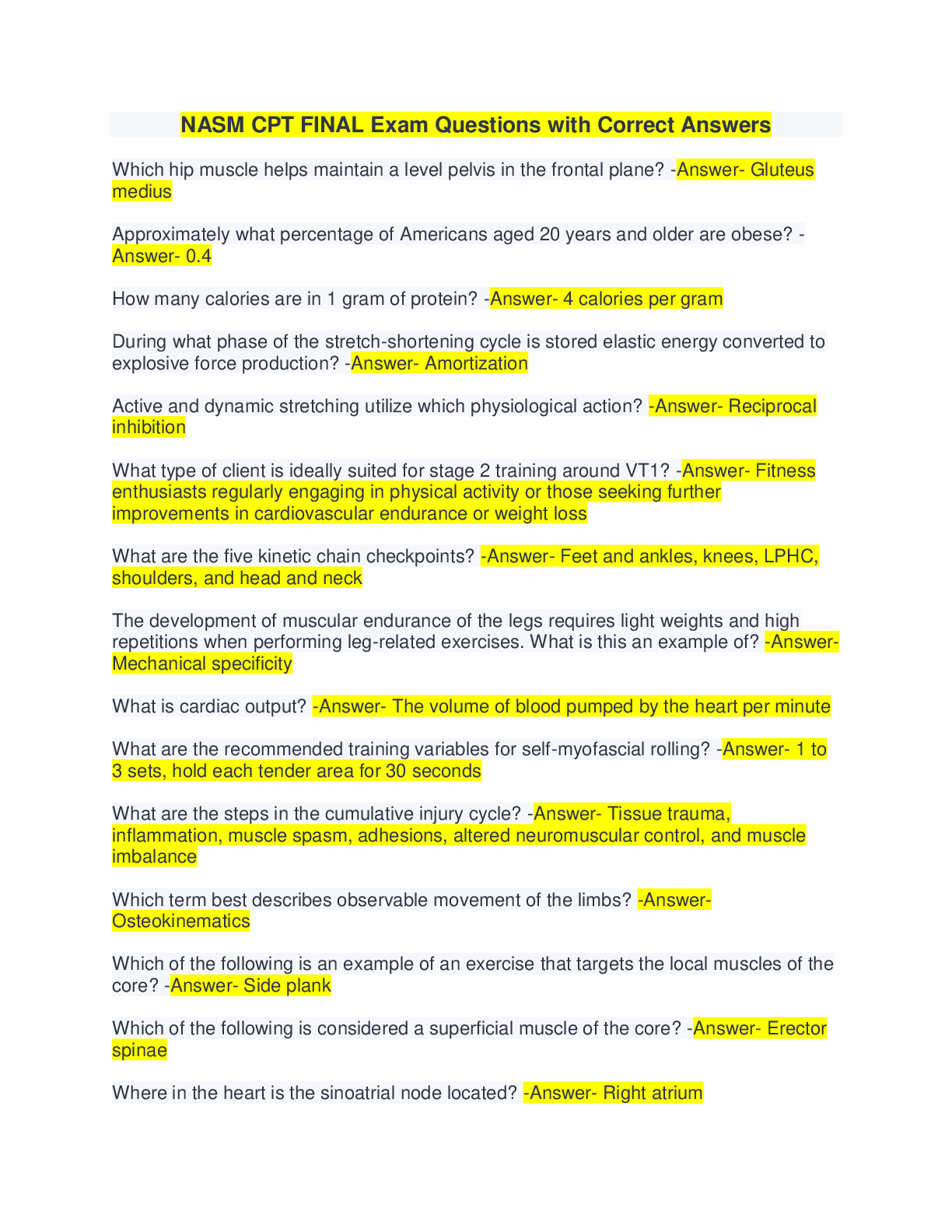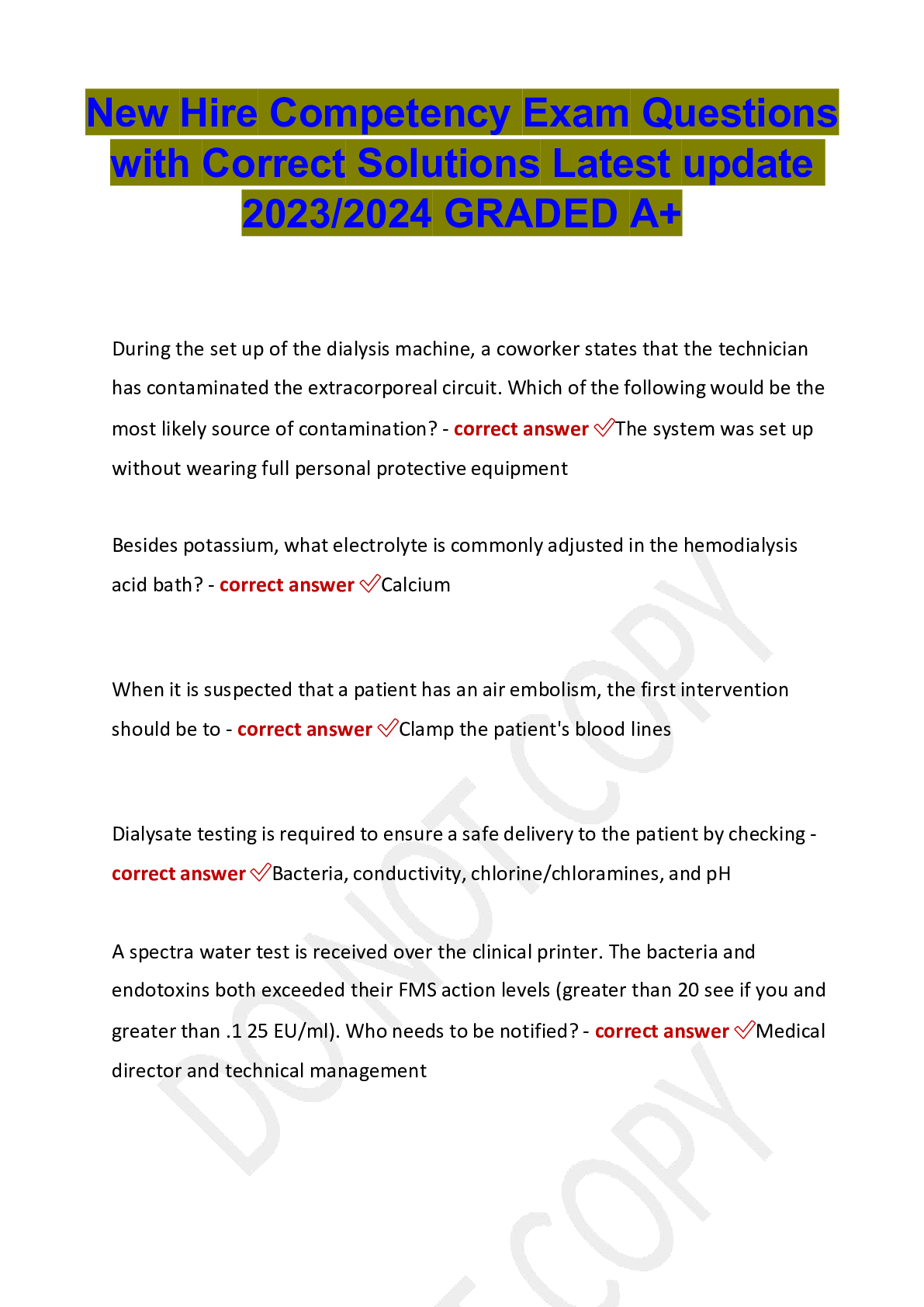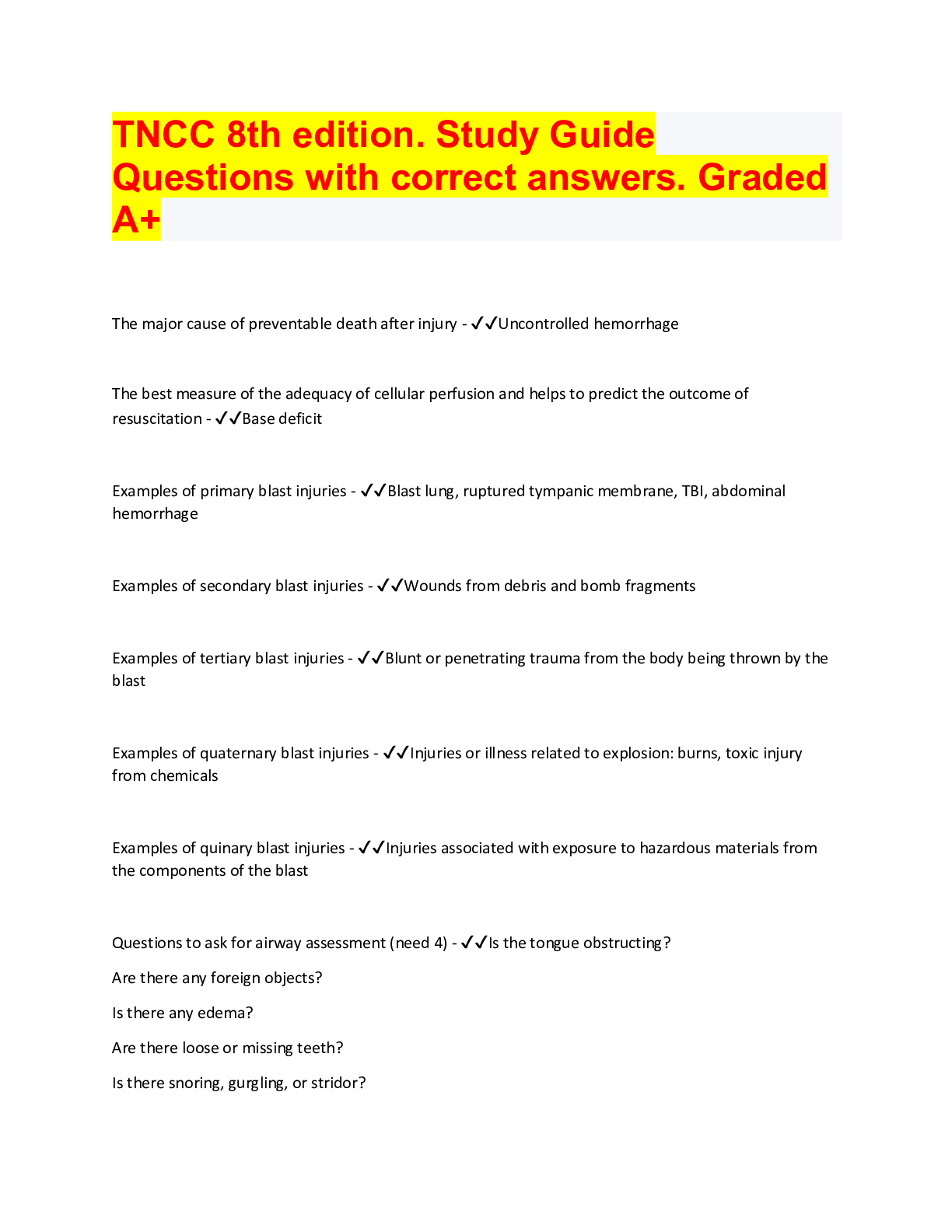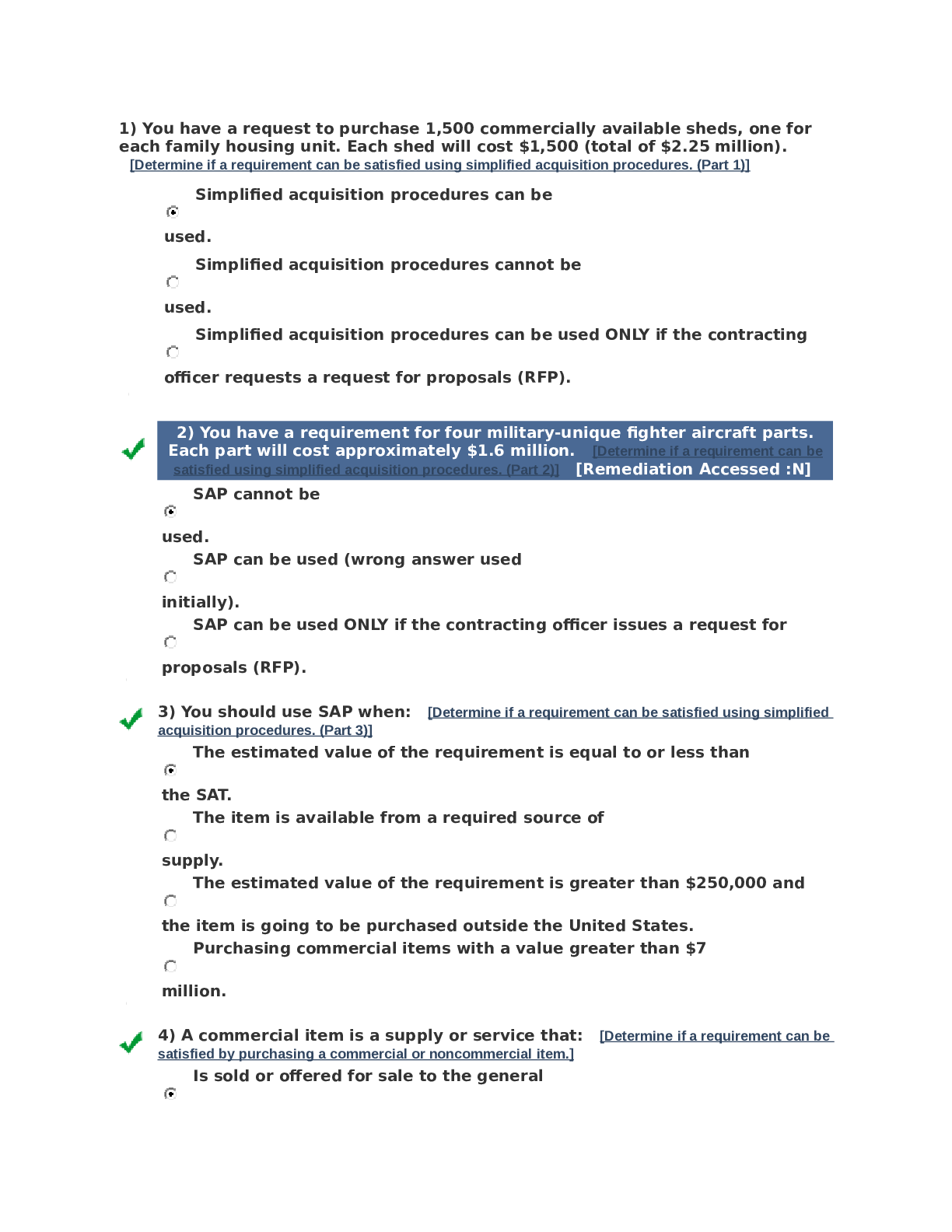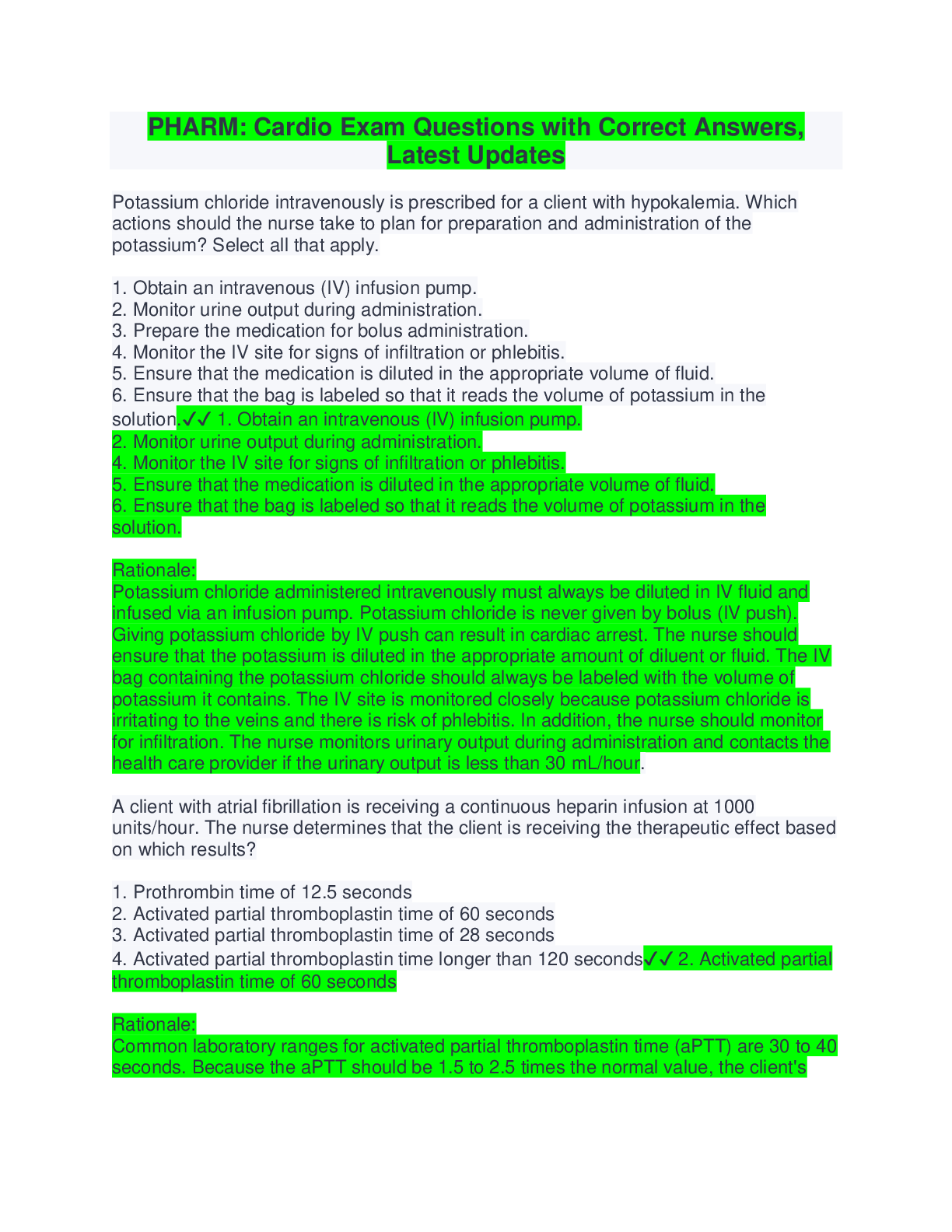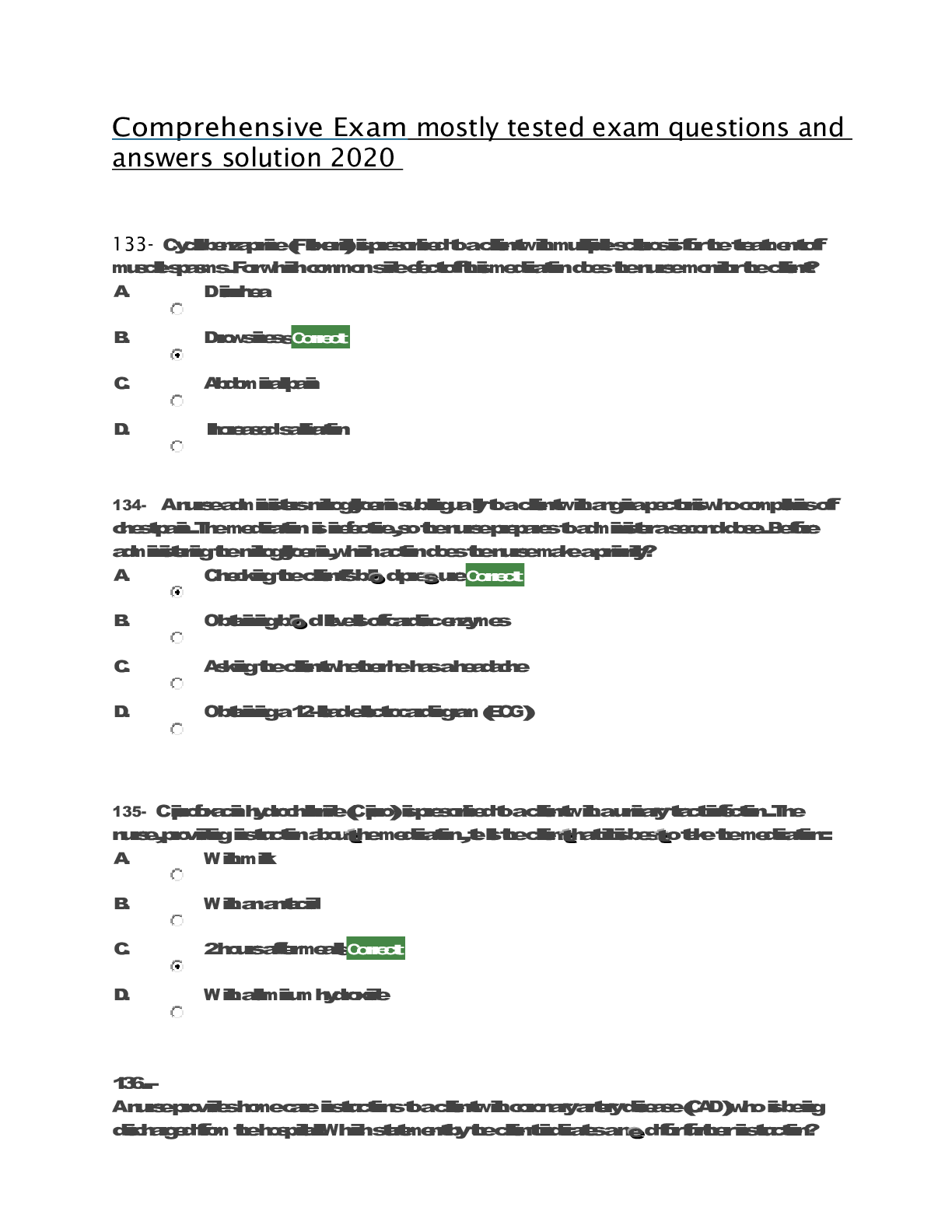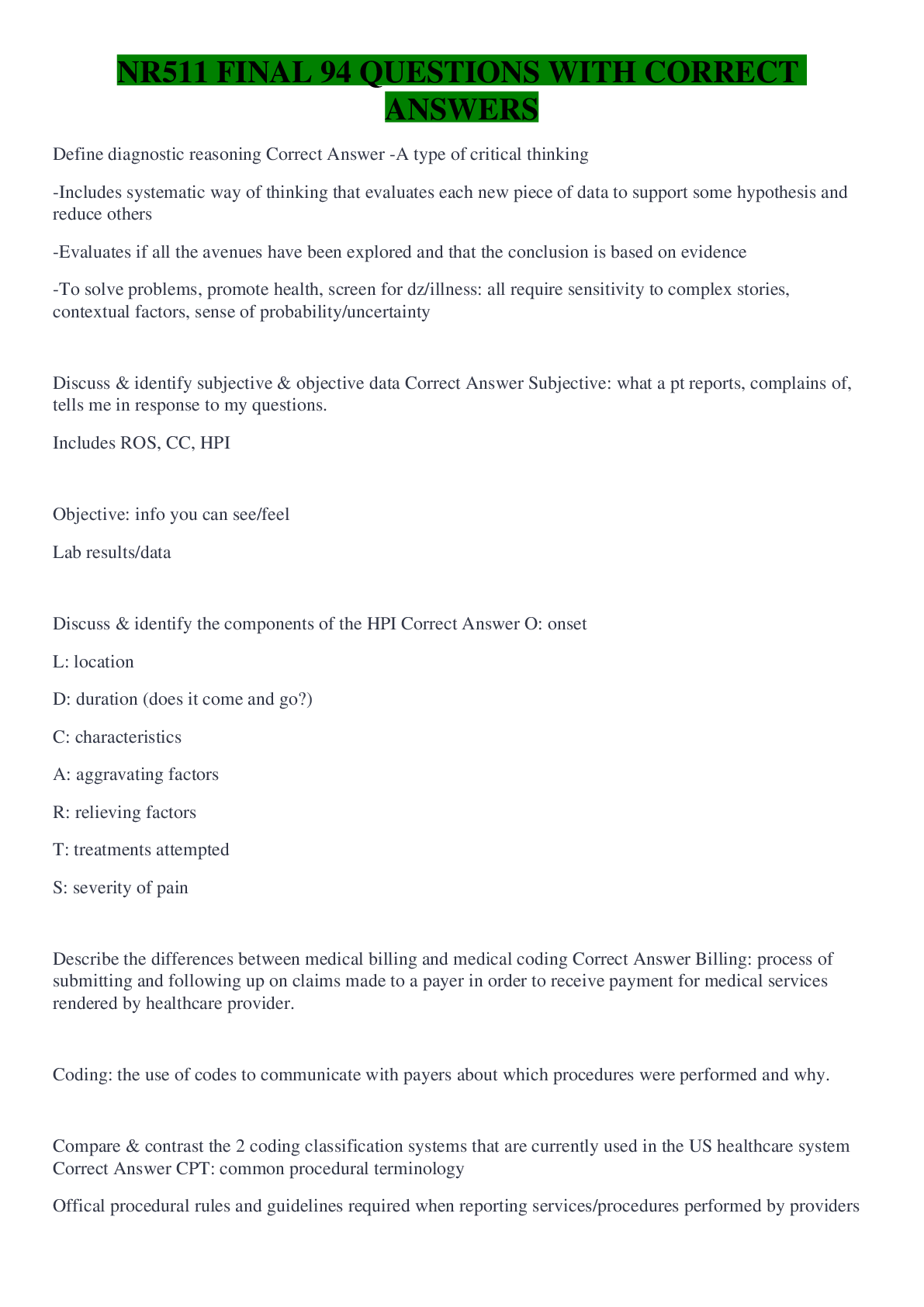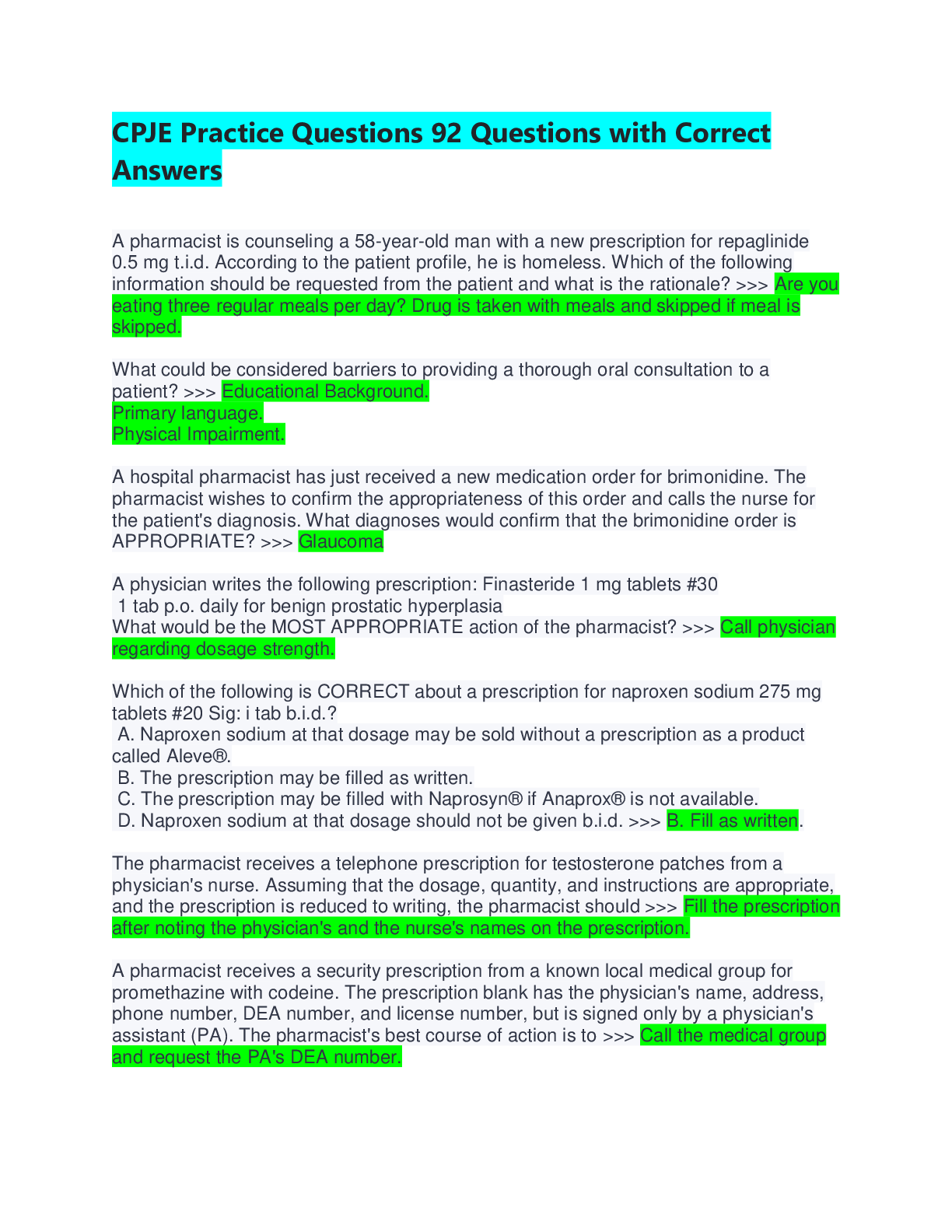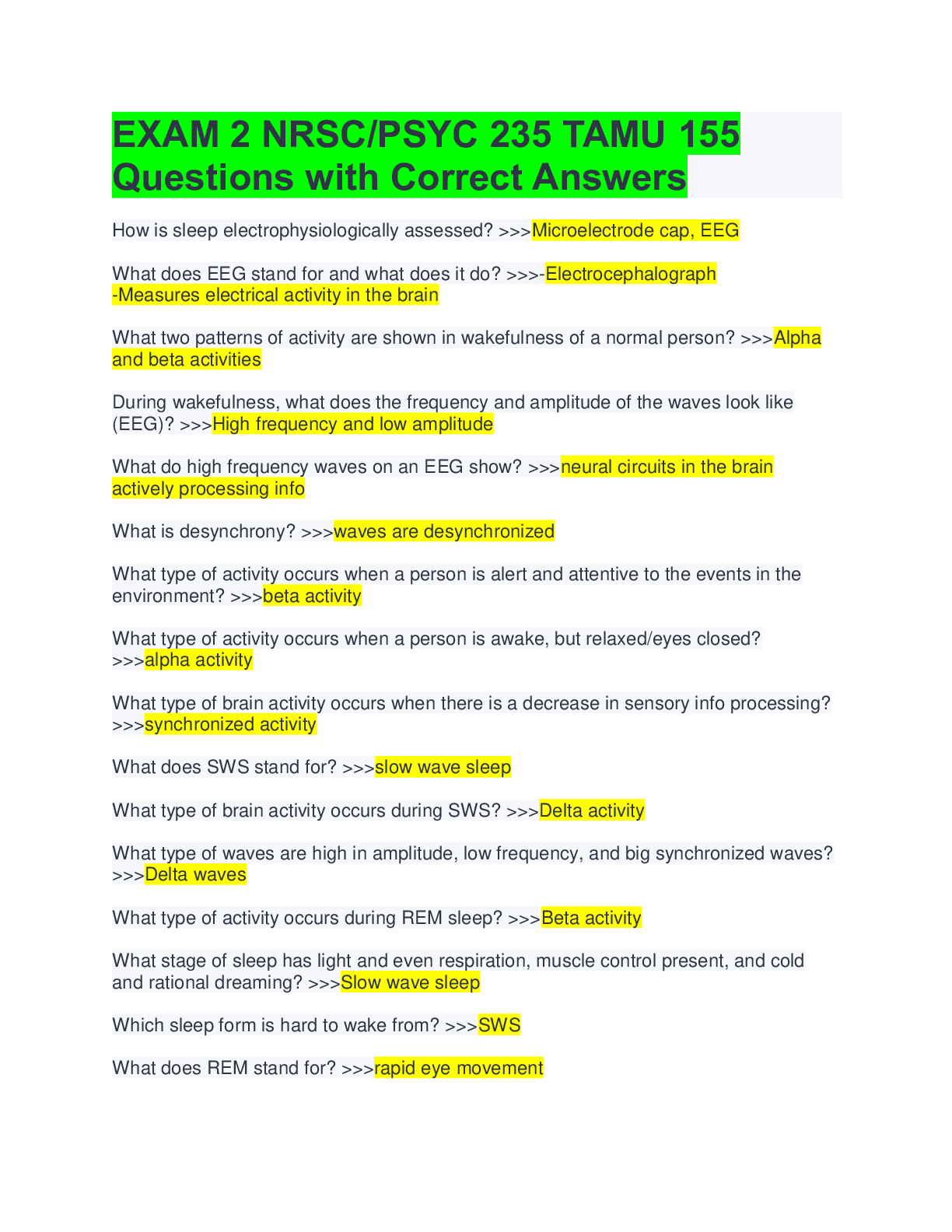*NURSING > QUESTIONS & ANSWERS > Emergency Medical Technician (EMT) Final Exam. Containing 100 Questions with Correct Answers Highlig (All)
Emergency Medical Technician (EMT) Final Exam. Containing 100 Questions with Correct Answers Highlighted.
Document Content and Description Below
EMS FINAL EXAM 1. A young female presents with costovertebral angle tenderness. She is conscious and alert with stable vital signs. Which of the following organs is MOST likely causing her pain? A)... Liver B) Kidney C) Pancreas D) Gallbladder 2. A patient whose speech is slurred and difficult to understand is experiencing: A) aphasia. B) dysarthria. C) dysphagia. D) paraplegia. 3. Dyspnea is MOST accurately defined as: A) shortness of breath or difficulty breathing. B) a complete cessation of respiratory effort. C) a marked increase in the exhalation phase. D) labored breathing with reduced tidal volume. 4. Which of the following questions would you ask a patient to ascertain the “M” in the SAMPLE history? A) “Have you ever had any major surgeries?” B) “How long have you had your chest pain?” C) “How much Tylenol do you take each day?” D) “When was the last time that you ate a meal?” 5. When palpating a patient's pulse, you note that it is grossly irregular. You should: A) count the pulse rate for at least 30 seconds to ensure accuracy. B) count the number of pulsations in 15 seconds and multiply by 4. C) count the number of pulsations in 30 seconds and multiply by 2. D) count the pulse rate for a full minute to obtain an accurate reading. 6. Which of the following statements regarding hemophilia is MOST correct? A) Hemophilia is defined as a total lack of platelets. B) Patients with hemophilia may bleed spontaneously. C) Hemophiliacs take aspirin to enhance blood clotting. D) Approximately 25% of the population has hemophilia. 7. Which of the following medications blocks the release of histamines? A) Adrenaline B) Epinephrine C) Diphenhydramine D) Acetaminophen8. You are attempting to resuscitate a 50-year-old male in cardiac arrest. He is on the second floor of his home. What is the MOST appropriate device to use when carrying him to the first floor? A) Long backboard B) Wheeled stretcher C) Folding stair chair D) Portable stretcher 9. Which of the following statements regarding abdominal eviscerations is MOST correct? A) Most eviscerations occur to the left upper quadrant. B) The protruding organs should be kept warm and moist. C) The organs should carefully be replaced to avoid heat loss. D) Adherent material is preferred when covering an evisceration. 10. Index of suspicion is MOST accurately defined as: A) the way in which traumatic injuries occur. B) a predictable pattern that leads to serious injuries. C) concern for potentially serious underlying injuries. D) the detection of less obvious life-threatening injuries. 11. A nuchal cord is defined as an umbilical cord that: A) has separated from the placenta. B) is wrapped around the baby's neck. C) is lacerated due to a traumatic delivery. D) has abnormally developed blood vessels. 12. When caring for a patient who takes numerous medications, it is best to: A) document the medications on your patient care report, but leave them at home so they do not get misplaced. B) take all of the patient's medications with you to the hospital and document them on your patient care report. C) send the patient's medications to the hospital with a family member or other person who will safeguard them. D) let the hospital staff retrieve the patient's medical records, which should show a list of his or her current medications. 13. In contrast to a behavioral crisis, a psychiatric emergency occurs when a person: A) demonstrates agitation or violence or becomes a threat to self or others. B) experiences feelings of sadness and despair for greater than one month. C) exhibits impaired functioning due to a chemical or genetic disturbance. D) experiences a sudden attack of panic secondary to a stressful situation.14. Once a cervical collar has been applied to a patient with a possible spinal injury, it should not be removed unless: A) the patient adamantly denies neck pain. B) lateral immobilization has been applied. C) it causes a problem managing the ABCs. D) sensory and motor functions remain intact. 15. Shock is the result of: A) hypoperfusion to the cells of the body. B) the body's maintenance of homeostasis. C) temporary dysfunction of a major organ. D) widespread constriction of the blood vessels. 16. The __________________ is a prominent bony mass that is located at the base of the skull and posterior to the ear. A) orbital socket B) sphenoid fossa C) zygomatic arch D) mastoid process 17. Pelvic inflammatory disease (PID) is an infection of the: A) testicles. B) gallbladder. C) urinary bladder. D) fallopian tubes. 18. Ketone production is the result of: A) acidosis when blood glucose levels are low. B) blood glucose levels higher than 120 mg/dL. C) fat metabolization when glucose is unavailable. D) rapid entry of glucose across the cell membrane. 19. Your partner, a veteran EMT-B who you have worked with regularly for the past 4 years, seems unusually agitated during a call involving an elderly patient. Upon arrival back at your station, you note the obvious smell of alcohol on his breath. What should you do? A) Remain quiet and simply request another partner. B) Report the incident to your EMS medical director. C) Discreetly report your suspicions to your supervisor. D) Tell your partner that he must seek professional help.20. You respond to an office building to find a middle-aged male in cardiac arrest. Coworkers are performing CPR and state that the patient has been down for approximately 10 minutes. You attach the AED, push the analyze button, and receive a “shock advised” message. You should: A) ensure that nobody is touching the patient and then defibrillate. B) continue CPR for 1 minute and reanalyze the patient's rhythm. C) transport immediately and request a paramedic unit rendezvous. D) call medical control and request permission to stop resuscitation. 21. Vesicant agents include all of the following, EXCEPT: A) sarin. B) lewisite. C) sulfur mustard. D) phosgene oxime. 22. You are dispatched to the county jail for an inmate that is “sick.” When you arrive, you find the patient, a 33-year-old male, unresponsive. His airway is patent and his respirations are rapid and shallow. Your initial action should be to: A) apply a pulse oximeter. B) request a paramedic unit. C) provide assisted ventilation. D) obtain his blood pressure. 23. The MOST serious complication associated with using a nasopharyngeal airway in a patient with head trauma is: A) fracturing the septum. B) damaging the turbinates. C) penetrating the cranium. D) causing severe bleeding. 24. Braxton-Hicks contractions are characterized by: A) regular contractions of progressively increasing intensity. B) alleviation of pain with movement or changing positions. C) pink or red bloody show in conjunction with the contractions. D) a rupture of the amniotic sac just before the contractions begin. 25. Eclampsia is MOST accurately defined as: A) high levels of protein in the patient's urine. B) hypertension in the 20th week of pregnancy. C) seizures that result from severe hypertension. D) a blood pressure greater than 140/90 mm Hg. 26. In addition to external bleeding, the MOST significant risk that an open soft tissue injury exposes a patient to is:A) infection. B) hypothermia. C) nerve damage. D) vessel damage. 27. You are treating a man with a closed head injury following an assault by a burglar. The patient, who has slurred speech, becomes verbally abusive and tells you to "leave him alone." You should: A) ask a police officer to transport the patient to the hospital. B) allow him to refuse treatment since the injury was not his fault. C) proceed with treatment and utilize law enforcement if necessary. D) have the police arrest him so that you can legally begin treatment. 28. The ONLY indications for placing your gloved fingers in the vagina during delivery are: A) breech presentation and prolapsed umbilical cord. B) limb presentation and severe vaginal hemorrhage. C) vertex presentation and delivery of the placenta. D) nuchal cord and presentation of an arm or leg. 29. Which of the following statements regarding stridor is MOST correct? A) It is a whistling sound heard in the lower airway. B) Stridor is caused by incorrect airway positioning. C) It is a high-pitched, crowing upper airway sound. D) Stridor suggests the presence of fluid in the lungs. 30. Delirium tremens (DTs) is a syndrome associated with withdrawal from: A) cocaine. B) opioids. C) alcohol. D) sedatives. 31. The purpose of a “jump kit” is to: A) facilitate defibrillation within 5 to 10 minutes after making patient contact. B) manage a critically injured patient until he or she is loaded into the ambulance. C) carry advanced life support equipment approved by the EMS medical director. D) contain anything that you might need during the first 5 minutes of patient care. 32. Infection should be considered as a possible cause of an airway obstruction in an infant or child, especially if he or she presents with: A) severe restlessness. B) drooling or congestion. C) skin that is cool and dry. D) acute respiratory distress.33. Pain felt at a location other than its origin is called: A) referred pain. B) radiating pain. C) visceral pain. D) remote pain. 34. While using lights and siren, most state laws permit an ambulance to: A) disregard all traffic control signals. B) drive as fast as the department allows. C) carefully exceed the posted speed limit. D) proceed through red lights without stopping. 35. The ___________ officer is responsible for notifying area hospitals and determining their availability and capabilities. A) triage B) medical C) treatment D) transportation 36. Erosion of the stomach or duodenum secondary to overactivity of digestive juices results in: A) ileus. B) an ulcer. C) appendicitis. D) cholecystitis. 37. Which of the following statements regarding the incident command system (ICS) is MOST correct? A) The ICS is only activated if a natural disaster occurs. B) The ICS is designed for use in daily EMS operations. C) The EMS system developed and implemented the ICS. D) The ICS is only effective during a mass casualty incident. 38. Your BEST protection against legal liability when a competent patient refuses EMS care and transport is to: A) advise medical control of the situation. B) err on the side of caution and transport. C) ensure the family is aware of the risks. D) thoroughly document the entire event. 39. A 19-year-old female is found unconscious by her roommate. Your initial assessment reveals that her breathing is inadequate. As you insert an oropharyngeal airway, she begins to gag violently. You should: A) continue to insert the airway as you suction her oropharynx.B) remove the airway and be prepared to suction her oropharynx. C) insert the airway no further but leave it in place as a bite block. D) select a smaller sized oral airway and attempt to insert it. 40. Which of the following MOST accurately describes a focal seizure? A) A seizure that begins in one extremity B) A blank stare without muscle contractions C) A seizure that is not preceded by an aura D) Generalized seizures without incontinence 41. A frostbitten foot can be identified by the presence of: A) gross deformity. B) soft, smooth skin. C) mottling and blisters. D) blanching of the skin. 42. Normally, no more than two patients are placed in the same ambulance; however, if severe weather conditions exist, a _________ patient may be transported in the passenger seat of the ambulance. A) red-tagged B) black-tagged C) green-tagged D) yellow-tagged 43. The posterior tibial pulse can be palpated: A) on the dorsum of the foot. B) above the lateral malleolus. C) in the fossa behind the knee. D) behind the medial malleolus. 44. A 26-year-old woman complains of a stabbing pain in the right lower quadrant of her abdomen. She states that her last menstrual period was 7 weeks ago and that she had pelvic inflammatory disease approximately 3 months ago. You should be MOST suspicious that this patient is experiencing: A) an acute appendicitis. B) an intrapelvic infection. C) a spontaneous abortion. D) an ectopic pregnancy. 45. Botulinum is: A) an acute viral infection. B) a disease of the leukocytes. C) rarely associated with death.D) a potent bacterial neurotoxin. 46. The largest portion of the brain, which is commonly referred to as the “gray matter,” is called the: A) cerebrum. B) cerebellum. C) brain stem. D) diencephalon. 47. You are transporting a 49-year-old male with “tearing” abdominal pain. You are approximately 30 miles away from the closest hospital. During your ongoing assessment, you determine that the patient's condition has deteriorated significantly. You should: A) begin ventilatory assistance with a BVM device. B) immediately perform a detailed physical examination. C) continue transporting and alert the receiving hospital. D) consider requesting a rendezvous with an ALS unit. 48. In which of the following patients should you remove an impaled object? A) A semiconscious patient with an ice pick impaled in the chest. B) An apneic patient with a shard of glass impaled in the abdomen. C) A pulseless and apneic patient with a knife impaled in the back. D) A conscious and alert patient with a fishhook impaled in the eye. 49. The body's functions that occur without conscious effort are regulated by the __________ nervous system. A) sensory B) somatic C) autonomic D) voluntary 50. You are transporting a 54-year-old male in cardiac arrest. A first responder is driving the ambulance as you and your partner attempt to resuscitate the patient. What is the MOST logical way of notifying the hospital? A) Call the receiving hospital with your cellular phone as you attempt resuscitation. B) Have the driver contact dispatch and relay the patient information to the hospital. C) Request that a police officer respond to the hospital to apprise them of your arrival. D) Wait until you arrive at the hospital and then quickly apprise them of the situation. 51. In order to facilitate a safe and coordinated move, the team leader should: A) be positioned at the feet so the team can hear. B) use preparatory commands to initiate any moves. C) speak softly but clearly to avoid startling the patient. D) never become involved in the move, just direct the move.52. While on duty, your partner asks you out on a date and touches you in an inappropriate location without your consent. You should: A) tell your partner to quit kidding around and focus on his or her job. B) warn your partner that you will report him or her if it happens again. C) notify law enforcement personnel and have your partner arrested. D) tell your partner to stop and report the incident to your supervisor. 53. Which of the following is an example of a symptom? A) Cyanosis B) Headache C) Tachycardia D) Hypertension 54. The primary organ responsible for absorption of products of digestion is the: A) pancreas. B) gallbladder. C) small intestine. D) large intestine. 55. A 25-year-old unrestrained female struck the steering wheel with her chest when her car hit a tree while traveling at a high rate of speed. She is experiencing signs and symptoms of shock, which you suspect are the result of intrathoracic bleeding. Which of the following interventions will provide this patient with the greatest chance for survival? A) 100% oxygen administration B) Full immobilization of her spine C) Applying and inflating the PASG D) Rapid transport to a trauma center 56. Patients with acute abdominal pain should not be given anything by mouth because: A) it will create referred pain and obscure the diagnosis. B) food will rapidly travel through the digestive system. C) a full stomach may make emergency surgery dangerous. D) digestion prevents accurate auscultation of bowel sounds. 57. Patients with rib fractures will commonly: A) breathe rapidly and shallowly. B) take a series of deep breaths. C) prefer to lie in a supine position. D) develop a sucking chest wound. 58. To assess a patient's general temperature, pull back on your glove and place the back of your hand on his or her skin at the: A) neck. B) chest.C) abdomen. D) forehead. 59. Which of the following statements is MOST consistent with the bargaining phase of the grieving process? A) “It is because of our lousy healthcare system that I developed this brain tumor.” B) “I will be compliant with all my medications if I can just see my grandson graduate.” C) “I understand that my death is inevitable and am ready to die when the time comes.” D) “The doctors must be wrong in their diagnosis because I have always been healthy.” 60. Which of the following MOST accurately defines negligence? A) Transport of a mentally incompetent patient against his or her will B) Deviation from the standard of care that may result in further injury C) Transferring patient care to a provider with a lower level of training D) Providing care that is consistent with care provided by other EMT-Bs 61. Maintaining a “cushion of safety” when operating an ambulance means: A) remaining in the far right-hand lane when transporting a critical patient and refraining from passing other motorists on the left side. B) driving at the posted speed limit, regardless of the patient's condition, and routinely using your lights and siren when driving on a freeway. C) driving about 2 to 3 seconds behind any vehicles in front of you and exceeding the posted speed limit by no more than 20 to 25 miles per hour. D) keeping a safe distance between your ambulance and vehicles in front of you and remaining aware of vehicles potentially hiding in your mirror's blind spots. 62. Clouding of the lenses of the eyes is called: A) retinitis. B) cataracts. C) glaucoma. D) conjunctivitis. 63. What medication form does oral glucose come in? A) Gel B) Liquid C) Suspension D) Fine powder 64. Syrup of ipecac is no longer recommended to treat patients who have ingested a poisonous substance because it: A) has been linked to hypotension.B) does not effectively induce vomiting. C) may result in aspiration of vomitus. D) has toxic effects on the myocardium. 65. You have been dispatched to a nearby bar, where a man has been stabbed. As you pull up in front of the bar, a man in an apron yells that he is the bartender and that "the crazy guy inside has a knife." You should: A) enter the bar with your partner and overpower the man with the knife. B) carefully enter the bar and begin caring for the patient who was stabbed. C) remain outside until the scene is secured by law enforcement personnel. D) ask the man inside the bar to drop the knife and slowly exit the building. 66. An alert patient presents with a regular pattern of inhalation and exhalation and breath sounds that are bilaterally clear and equal. These findings are MOST consistent with: A) an obstructed airway. B) adequate air exchange. C) respiratory difficulty. D) respiratory insufficiency. 67. Anaphylaxis is MOST accurately defined as a/an: A) moderate allergic reaction that primarily affects the vasculature. B) extreme allergic reaction that may affect multiple body systems. C) severe allergic reaction that typically resolves without treatment. D) allergic reaction that causes bronchodilation and vasoconstriction. 68. A patient with atherosclerotic heart disease experiences chest pain during exertion because the: A) coronary arteries suddenly spasm and cause a marked reduction in myocardial blood flow. B) lumen of the coronary artery is narrowed and cannot accommodate increased blood flow. C) tissues of the myocardium undergo necrosis secondary to a prolonged absence of oxygen. D) ragged edge of a tear in the coronary artery lumen causes local blood clotting and arterial narrowing. 69. The principle clinical difference between a stroke and hypoglycemia is that patients with hypoglycemia: A) always take oral medications to maintain normal blood glucose levels. B) do not present with slurred speech or weakness to one side of the body. C) are typically alert and attempt to communicate with healthcare providers. D) usually have an altered mental status or decreased level of consciousness. 70. Which of the following is a late sign of shock in a patient with acute abdominal pain? A) Hypotension B) Tachycardia C) TachypneaD) Diaphoresis 71. Any unconscious trauma patient should be assumed to have: A) a history of diabetes mellitus. B) an accompanying spinal injury. C) a severe intracranial hemorrhage. D) internal bleeding in the abdomen. 72. In addition to severe bleeding, the MOST life-threatening complication associated with an open neck injury is: A) an air embolism. B) a spinal fracture. C) an ischemic stroke. D) nerve fiber damage. 73. It is MOST important for the EMT-B to remember that suicidal patients may: A) inject illicit drugs. B) be self-destructive. C) be homicidal as well. D) have a definitive plan. 74. You respond to a call for a female pedestrian that has been struck by a car. As your partner maintains manual stabilization of her head, you perform an initial assessment. She is unconscious, has ineffective breathing, and bloody secretions in her mouth. You should: A) assist ventilations with a BVM device. B) quickly insert an oropharyngeal airway. C) assess the rate and quality of her pulse. D) immediately suction her oropharynx. 75. Points of distribution (PODs) are strategically placed facilities where: A) weapons of mass destruction are distributed. B) chemical and biological weapons are stockpiled. C) antidotes, antibiotics, and vaccines are distributed. D) chemical weapons are manufactured and distributed. 76. Which of the following medication routes has the slowest rate of absorption? A) Rectal B) Ingestion C) Inhalation D) Sublingual 77. The iliac arteries immediately subdivide into the: A) femoral arteries. B) peroneal arteries.C) anterior tibial arteries. D) posterior tibial arteries. 78. Traction splints are used primarily to immobilize and secure fractures of the: A) hip. B) pelvis. C) femur. D) humerus. 79. When faced with a situation in which a patient is in cardiac arrest, and a valid living will or do not resuscitate (DNR) order cannot be located, you should: A) begin resuscitation at once. B) contact medical control first. C) determine the patient's illness. D) notify the coroner immediately. 80. A driver involved in a rollover motor vehicle crash will MOST likely experience serious injuries or death if he or she: A) is wearing only a lap belt. B) remains within the vehicle. C) experiences multiple impacts. D) is ejected or partially ejected. 81. Following delivery of a full-term baby, you have properly cared for the baby and have clamped and cut the umbilical cord. During transport, you note that the mother is experiencing moderate vaginal bleeding. You should: A) elevate her legs 6” to 8” and cover her with a blanket. B) firmly massage the uterine fundus with a circular motion. C) carefully insert a sterile trauma dressing into her vagina. D) place her legs together and position her on her left side. 82. The components of the pediatric assessment triangle (PAT) are: A) appearance, work of breathing, and skin circulation. B) mental status, heart rate, and systolic blood pressure. C) skin condition, respiratory rate, and level of alertness. D) activity, respiratory quality, and level of consciousness. 83. You receive a call for a 70-year-old female with respiratory distress. Her husband tells you that she has congestive heart failure; however, he does not think that she has been taking her medications as prescribed. The patient is laboring to breathe, appears tired, and has cyanosis around her lips. You should: A) begin assisting her ventilations with a BVM. B) apply a pulse oximeter and obtain vital signs. C) administer oxygen via a nonrebreathing mask.D) obtain a complete list of all of her medications. 84. A 59-year-old male with a history of emphysema complains of an acute worsening of his dyspnea and pleuritic chest pain following a forceful cough. Your assessment reveals that he has a barrel-shaped chest, unilaterally diminished breath sounds, and tachycardia. What is the MOST likely cause of this patient's condition? A) Rupture of the diaphragm B) Exacerbation of his COPD C) Acute pulmonary embolism D) Spontaneous pneumothorax 85. You respond to the residence of a 55-year-old female with a possible allergic reaction to peanuts that she ate approximately 30 minutes ago. The patient is conscious and alert, but has diffuse urticaria and the feeling that she has a lump in her throat. As your partner applies oxygen to the patient, you should: A) ask her if she has prescribed epinephrine. B) obtain a complete set of baseline vital signs. C) ascertain if she has a family history of allergies. D) ask her when her last allergic reaction occurred. 86. A drug is contraindicated for a patient when it: A) is used to treat a multitude of conditions. B) may cause harm or have no positive effect. C) produces actions other than the desired ones. D) is used to treat a specific medical condition. 87. A 62-year-old male presents with crushing chest pain, which he describes as being the same kind of pain that he had with a previous heart attack. He has prescribed nitroglycerin, but states that he has not taken any. After administering 100% oxygen and contacting medical control, you should: A) begin immediate transport and request a rendezvous with a paramedic unit. B) assist him with his nitroglycerin unless his systolic BP is less than 100 mm Hg. C) administer up to three doses of nitroglycerin before assessing his blood pressure. D) administer the nitroglycerin unless he has taken Viagra within the past 72 hours. 88. The MOST common and significant complication associated with an acute abdomen is: A) peritonitis. B) high fever. C) severe pain. D) internal bleeding. 89. A 22-year-old female patient is complaining of dyspnea, numbness, and tingling in her hands and feet after an argument with her fiancé. Her respirations are 40 breaths/min. You should: A) have her breathe into a paper or plastic bag.B) provide reassurance and give oxygen as needed. C) request a paramedic to give her a sedative drug. D) position her on her left side and transport at once. 90. Insulin shock will MOST likely develop if a patient: A) takes too much of his or her prescribed insulin. B) markedly overeats and misses an insulin dose. C) eats a regular meal followed by mild exertion. D) misses one or two prescribed insulin injections. 91. Which of the following nerves carry information from the body to the brain via the spinal cord? A) Motor B) Central C) Somatic D) Sensory 92. What maneuver should be used to open the airway of an unresponsive patient with suspected trauma? A) Tongue-jaw lift B) Jaw-thrust maneuver C) Head-tilt chin-lift D) Head-tilt neck-lift 93. The MOST significant complication associated with facial injuries is: A) damage to the eyes. B) airway compromise. C) cervical spine injury. D) mandibular immobility. 94. The nasal cannula is MOST appropriately used in the prehospital setting: A) when the patient cannot tolerate a nonrebreathing mask. B) if the patient's nasopharynx is obstructed by secretions. C) if long-term supplemental oxygen administration is required. D) when the patient breathes primarily through his or her mouth. 95. An incarcerated hernia is one that: A) spontaneously reduces without any surgical intervention. B) can be pushed back in the body cavity to which it belongs. C) loses its blood supply due to compression by local tissues. D) cannot be pushed back within its respective body cavity. 96. In contrast to inhalation, exhalation:A) requires muscular effort to effectively expel air from the lungs. B) is a passive process caused by increased intrathoracic pressure. C) occurs when the diaphragm lowers and expels air from the lungs. D) is an active process caused by decreased intrathoracic pressure. 97. Palliating factors regarding a patient's pain involve those that: A) worsen the pain. B) alleviate the pain. C) initiate the pain. D) change the pain. 98. A normal pulse should feel: A) strong and slow. B) bounding and rapid. C) thready and regular. D) strong and regular. 99. When caring for a 65-year-old male with respiratory distress, you place him in a comfortable position, but do not apply oxygen. The patient's condition continues to deteriorate and he develops cardiac arrest and dies at the hospital. This scenario is an example of: A) assault. B) battery. C) negligence. D) abandonment. 100. The MOST effective way to gain a patient's trust when he or she is communicating with you is to: A) repeatedly ask questions for clarification. B) ask the same questions to every patient. C) document the patient's words verbatim. D) maintain eye contact and actively listen. [Show More]
Last updated: 1 year ago
Preview 1 out of 16 pages
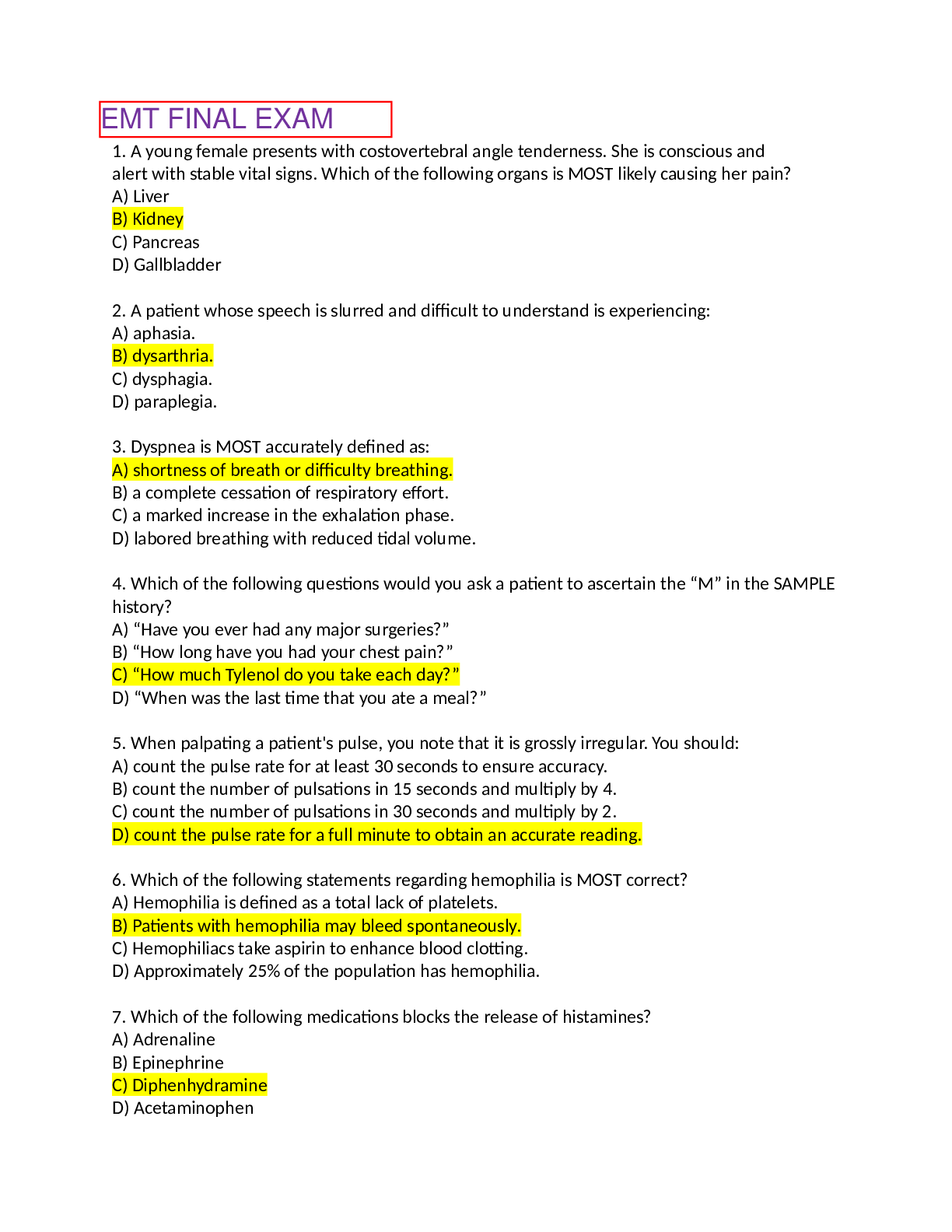
Reviews( 0 )
Document information
Connected school, study & course
About the document
Uploaded On
Nov 22, 2021
Number of pages
16
Written in
Additional information
This document has been written for:
Uploaded
Nov 22, 2021
Downloads
1
Views
321



